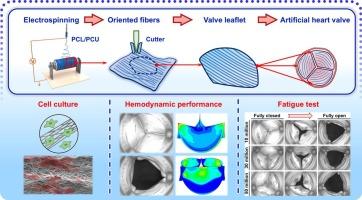各向异性静电纺丝聚(ε-己内酯)/聚碳酸酯聚氨酯支架在组织工程心脏瓣膜中的抗疲劳性能
IF 7.9
2区 材料科学
Q1 MATERIALS SCIENCE, MULTIDISCIPLINARY
引用次数: 0
摘要
本研究采用聚ε-己内酯(PCL)和聚碳酸酯聚氨酯(PCU)制备组织工程心脏瓣膜(TEHVs)电纺丝支架。含25% PCU (75%PCL-O)定向纤维的PCL/PCU支架表现出明显的各向异性,弹性模量分别为53.47±0.93 MPa (x轴)和4.19±0.70 MPa (y轴),抗拉强度分别为14.21±1.16 MPa (x轴)和1.59±0.09 MPa (y轴),接近天然心脏瓣膜。75%PCL-O支架表现出良好的细胞活力和引导细胞沿纤维排列,无明显溶血和血栓形成。水动力试验表明,25mm手术肺动脉瓣的有效孔面积(EOA)为2.42±0.12 cm2,反流分数(RF)为5.98±2.31%,符合ISO 5840-2标准。加速疲劳测试表明,在5000万次循环中,EOA和RF保持稳定。此外,有限元分析(FEA)表明,75%PCL-O阀瓣在开启-关闭循环过程中的机械应力集中在自由边缘,这与疲劳试验中观察到的这些区域的纤维退化有很好的相关性。综上所述,75%PCL-O支架具有良好的力学性能、良好的生物相容性和提高的耐久性,具有很大的应用潜力。本文章由计算机程序翻译,如有差异,请以英文原文为准。

Anisotropic electrospun poly(ε-caprolactone)/polycarbonate urethane scaffolds with improved fatigue performance for tissue-engineered heart valves
In this study, poly(ε-caprolactone) (PCL) and polycarbonate urethane (PCU) were used to fabricate electrospun scaffolds for tissue-engineered heart valves (TEHVs). The PCL/PCU scaffold containing 25 % PCU (named as 75%PCL-O) with oriented fibers exhibited pronounced anisotropy, with elastic moduli of 53.47 ± 0.93 MPa (X-axis) and 4.19 ± 0.70 MPa (Y-axis), and tensile strength of 14.21 ± 1.16 MPa (X-axis) and 1.59 ± 0.09 MPa (Y-axis), respectively, close to native heart valves. The 75%PCL-O scaffold showed good cell viability and guided cell alignment along the fibers, and no obvious hemolysis or thrombus formation. Hydrodynamic tests showed an effective orifice area (EOA) of 2.42 ± 0.12 cm2 and a regurgitant fraction (RF) of 5.98 ± 2.31 % for a 25 mm surgical pulmonary valve, meeting the ISO 5840-2 standard. The accelerated fatigue testing demonstrated that the EOA and RF remained stable throughout 50 million cycles. Additionally, finite element analysis (FEA) revealed that mechanical stress concentrated at the free edge for the 75%PCL-O valve leaflet during the opening-closing cycles, correlating well with the observed fiber degradation in these regions during fatigue tests. In summary, the 75%PCL-O scaffold exhibits favorable mechanical performance, good biocompatibility and improved durability, showing great potential for TEHV applications.
求助全文
通过发布文献求助,成功后即可免费获取论文全文。
去求助
来源期刊

Materials & Design
Engineering-Mechanical Engineering
CiteScore
14.30
自引率
7.10%
发文量
1028
审稿时长
85 days
期刊介绍:
Materials and Design is a multi-disciplinary journal that publishes original research reports, review articles, and express communications. The journal focuses on studying the structure and properties of inorganic and organic materials, advancements in synthesis, processing, characterization, and testing, the design of materials and engineering systems, and their applications in technology. It aims to bring together various aspects of materials science, engineering, physics, and chemistry.
The journal explores themes ranging from materials to design and aims to reveal the connections between natural and artificial materials, as well as experiment and modeling. Manuscripts submitted to Materials and Design should contain elements of discovery and surprise, as they often contribute new insights into the architecture and function of matter.
 求助内容:
求助内容: 应助结果提醒方式:
应助结果提醒方式:


